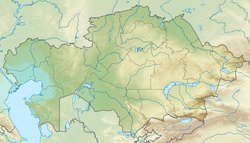Bostobe Formation
Stratigraphic Unit in Kazakhstan From Wikipedia, the free encyclopedia
The Bostobe Formation (Kazakh: Boztóbe svıtasy) is a geological formation in Qaraghandy & Qyzylorda, Kazakhastan whose strata date back to the Late Cretaceous (Santonian to early Campanian stages, approximately 85 Ma).
| Bostobe Formation | |
|---|---|
| Stratigraphic range: Santonian-early Campanian ~ | |
| Type | Geological formation |
| Underlies | Akzhar Formation |
| Overlies | Zhirkindek Formation |
| Thickness | About 45 m (148 ft) |
| Lithology | |
| Primary | Sandstone |
| Other | Claystone |
| Location | |
| Coordinates | 45.9°N 64.7°E |
| Approximate paleocoordinates | 38.7°N 58.0°E |
| Region | Qaraghandy & Qyzylorda |
| Country | Kazakhstan |
| Type section | |
| Named for | Bostobe River |
The sandstones and claystones of the formation were deposited in estuarine, fluvial-lacustrine and fluvial-deltaic environments.
Dinosaur remains are among the fossils that have been recovered from the formation.[1] The formation is about 45 metres (148 ft) thick and consists primarily of clay with interbeds of sand, representing an estuarine environment.[2]
Fossil content
Khunnuchelys lophorhothon, a trionychid turtle recovered from the formation, was initially thought to belong to a hadrosaurid dinosaur and classified as cf. Lophorhothon sp.[3]
- Mammals
- Ankylosaurs
- Ankylosauridae indet.
- Ornithopods
- Sauropods
- Opisthocoelicaudiinae Indet.
- Titanosauridae indet.
- Sauropoda indet.
- Theropods
- Caenagnathidae indet.
- Troodontidae indet.[6]
- Therizinosauria indet.[6]
- Ornithomimidae indet.[6]
- Tyrannosauroidea indet.
- Pterosaurs
- Turtles
- Adocus foveatus
- Anatolemys maximus
- Khunnuchelys lophorhothon[3]
- Lindholmemys gravis
- Shachemys baibolatica
- Trionyx kansaiensis, T. onomatoplokos, T. riabinini
- Other reptiles
- Bishara backa
- Amphibians
- Fish
- Flora
See also
References
Further reading
Wikiwand - on
Seamless Wikipedia browsing. On steroids.
